The United States entered the end of the 1800s scarred from the Civil War.
With the war over, the country moved forward, tired from such a ragged and brutal conflict.
However, the Civil War spurred firearm development forward, and we began seeing significant modernization from the war’s end to 1900.
Today we are going to discuss post-Civil War America and its conflicts, as well as the small arms of the Spanish-American war. So buckle in, and let’s look at how percussion caps evolved into metallic cartridges.
Table of Contents
Loading…
Post Civil War
In the wake of the Civil War, minor conflicts continued throughout the United States. The Unionized United States continued to battle Native American forces, mostly west of the Mississippi.
Lessons learned from the Civil War continued into these new battles, and so did many of their weapons.
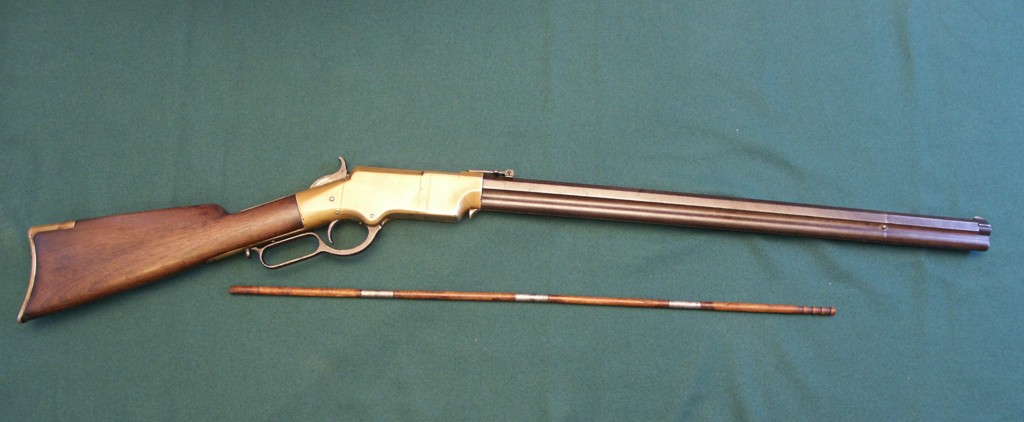
Guns like the Henry rifle and Spencer carbine stuck around with some forces. As did numerous revolvers and, of course, the Gatling gun.
The Gatling gun became more popular after the Civil War, and the Army slowly acquired them to bolster its forces.
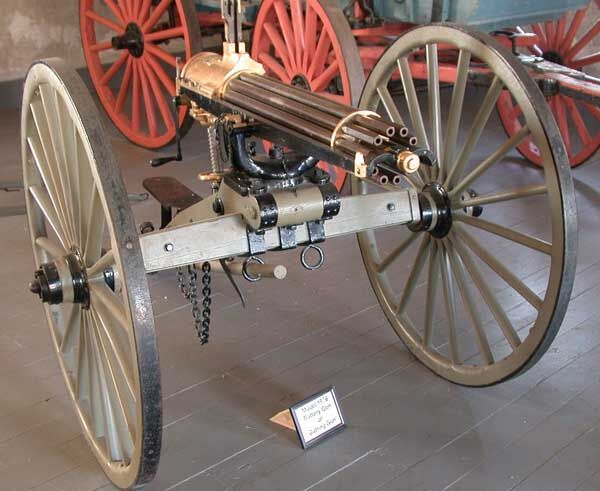
American Army soldiers fought the Ute, Navajo, and numerous other tribes throughout the American West. Native forces had no standard weaponry, and it wasn’t uncommon to see a wide variety of revolvers, rifles, and smoothbore firearms.
Trudging Forward
In 1866 the Army adopted the Remington Rolling Block rifle chambered in .50-70 Government and acquired cartridge conversions for Sharps and Springfield rifles. These acted as a stop-gap between percussion cap rifles and modern cartridge firearms.
The .50-70 Government was a metallic cartridge firearm with a centerfire ignition system. This caliber served notably during the Indian Wars.
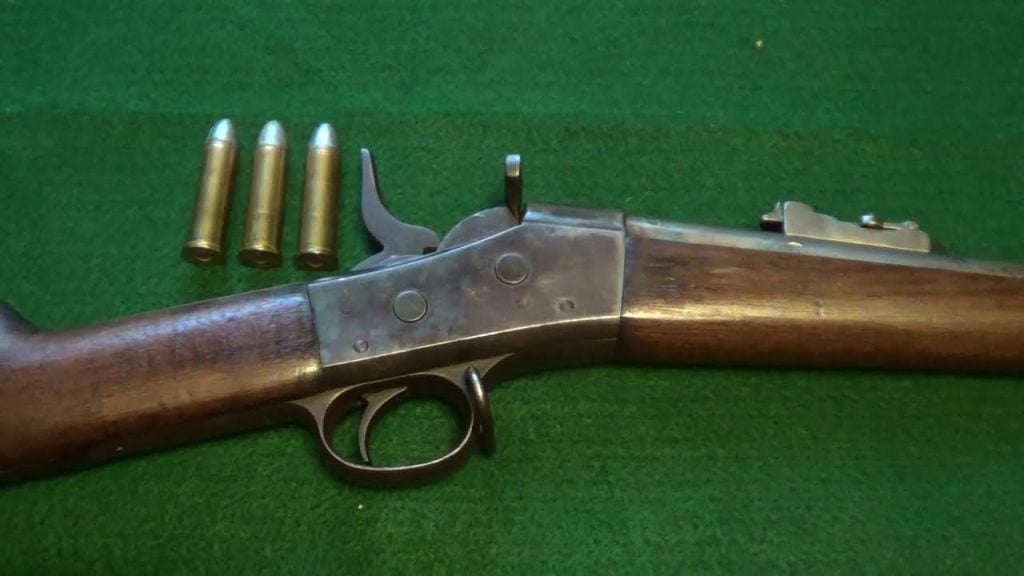
Twenty-six soldiers held off hundreds of Lakota Sioux warriors with their fast-loading rifles. They formed a defensive perimeter with their wagons and used these rifles to fend off attackers for hours.
Being able to rapidly reload rifles with cartridges made a significant difference in their ability to engage larger forces.
Enter the .45-70
The Army now replaced their various Springfield, Remington, and Sharps conversion rifles with the Springfield Model 1873 Trapdoor.
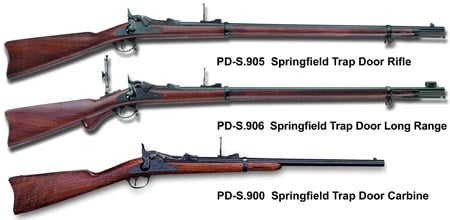
Springfield’s 1873 was the first standard-issue breech-loading rifle adopted by the United States Army.
As a metallic cartridge rifle, the weapon provided soldiers with a powerful gun chambered in .45-70 that could be rapidly loaded, fired, and reloaded. It was only a single-shot rifle but still allowed for much faster fire than a percussion cap rifle.
Amateur soldiers could load and fire eight rounds per minute, and experienced soldiers could reach 15 rounds per minute. The Springfield 1873 rifle was an accurate rifle, but black powder still caused issues by clouding the battlefield with gunsmoke.
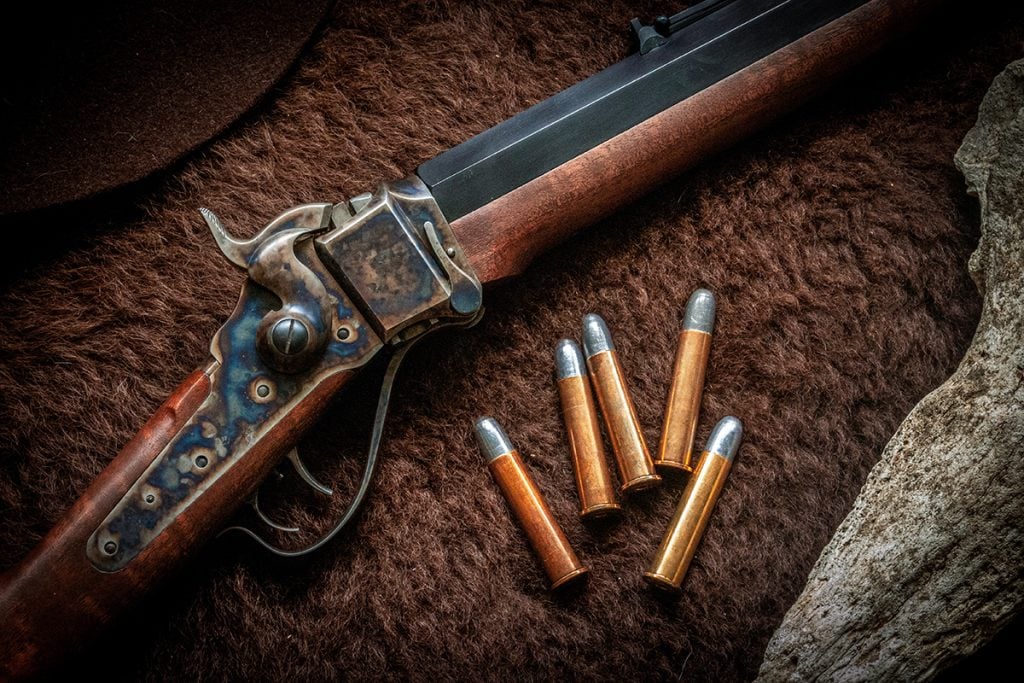
While range and accuracy were important, the rate of fire was more important due to the mass fire tactics at the time.
Like most rifles of the time, the Springfield Model 1873 was huge! It was 52 inches long and weighed about 9 pounds.
The First Bolt Action
A weapon called the Winchester Hotchkiss complimented the Springfield 1873.

The Winchester Hotchkiss was a bolt-action rifle chambered in .45-70 and began production in 1876. Both the Army and US Navy adopted the Winchester Hotchkiss in limited numbers.
This rifle became the first bolt action repeater adopted by a military force. The Winchester Hotchkiss shared sights, cleaning rods, and stock hardware with the Springfield 1873, simplifying training and repair.
The magazine design was an odd one — It fed from a tubular magazine in the stock of the rifle and held five rounds of .45-70. A magazine cut-off encourages users to fire and reload, saving the magazine for a rapid-fire emergency versus firing until empty.
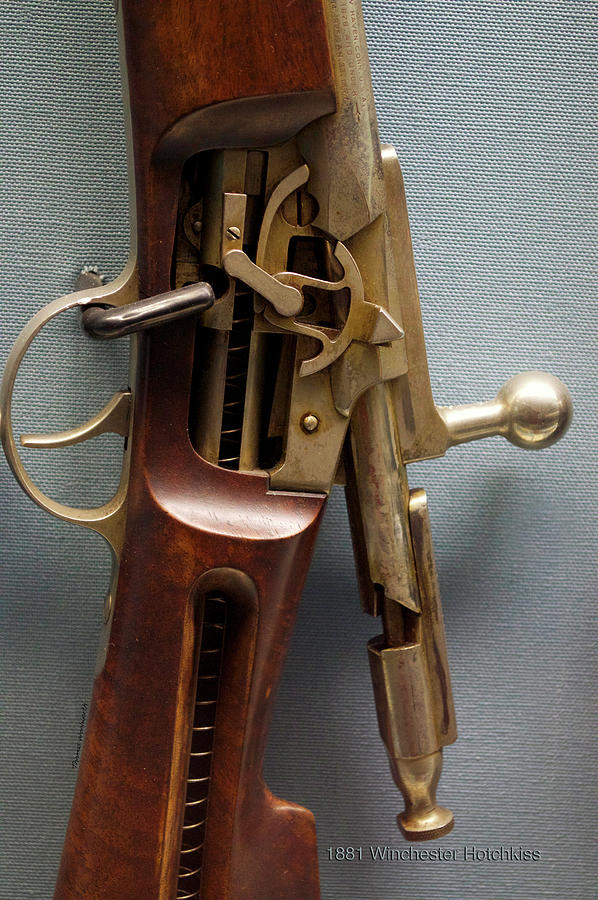
Both rifles and carbine models were produced for line infantry and cavalry forces.
The New Colt
In 1873 the Colt Single Action Army premiered and became the Glock 19 of its day.
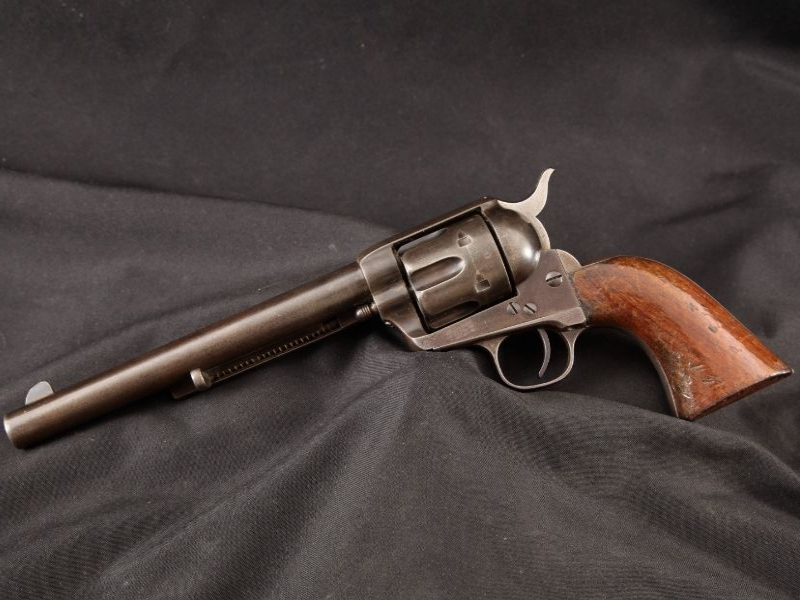
The Colt SAA, aka the Peacemaker, aka the M1873, aka that cowboy revolver from every movie, became the standard-issue sidearm for the United States military.
Although, as you’d imagine, there were tons of revolvers in the hands of soldiers at the time. The Army had purchased a number of Smith & Wesson revolvers, and numerous older Colts occupied the hands of state militias.
The Colt Single Action Army chambered the .45 Colt cartridge and held six rounds. The single-action design was all the rage at the time and promised an affordable and simplistic action.
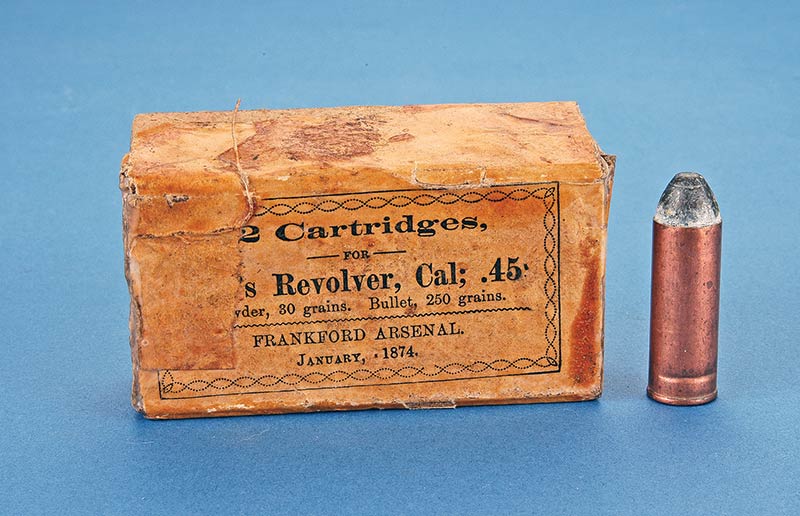
Originally, the Army adopted 7.5-inch barrel models but later refurbished the guns to 5.5 inches and purchased 5.5-inch models from then on.
Custer’s Last Stand
Battle of the Little Bighorn saw the famous General Geroge Custer lead the 7th Cavalry against the Lakota and Cheyenne warriors. His soldiers were armed with the new Colt revolvers and Springfield rifles.
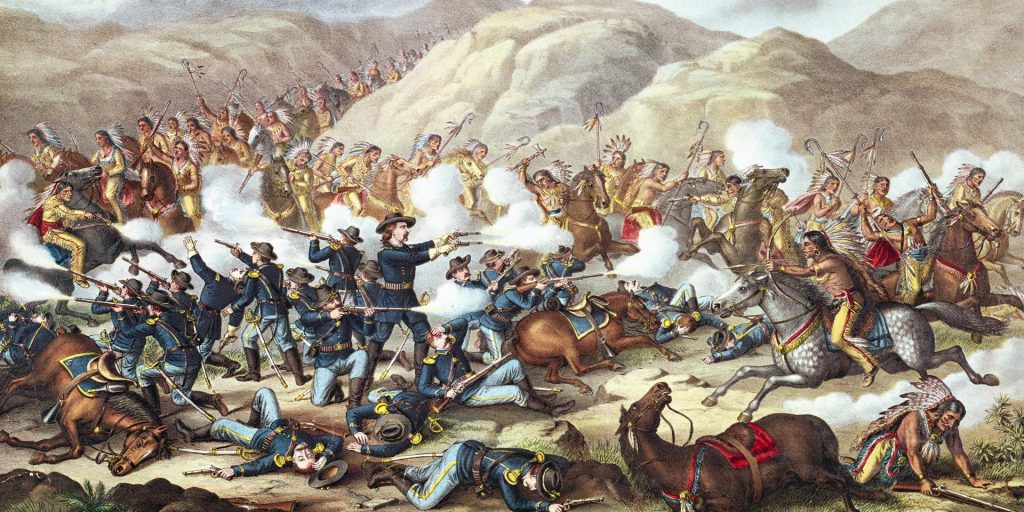
Custer rejected an offer of two Gatling guns before commencing his campaign. Why he did so is unclear, but it was likely due to their large size, difficulty moving them over rough terrain, and general reliability issues.
The Lakota and Cheyenne warriors were armed with a wide variety of rifles and handguns, from smoothbore muskets all the way to the best repeating guns of the day. In fact, 10% of the warriors were armed with lever-action rifles from Henry, Winchester, and Spencer.
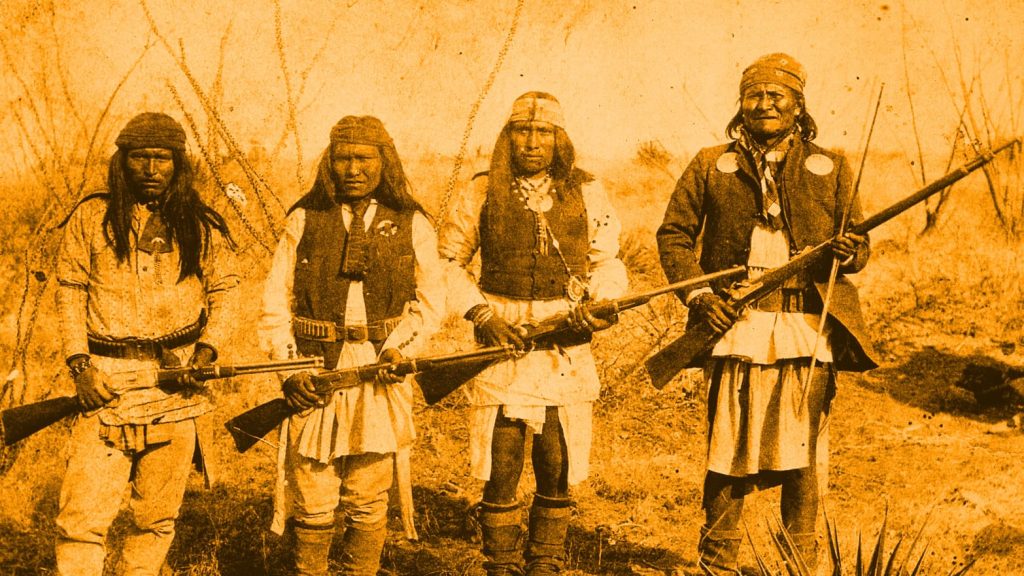
These rapid-fire rifles were highly effective against the slower reloading trapdoor rifles, and we call it Custer’s Last Stand for a reason, as the Lakota and Cheyenne decimated the Army’s forces.
Spanish-American War
In 1898 America went to war with Spain, Cuba, and Puerto Rico in Cuba. Here we saw several technological innovations come into play. In many ways, the Spanish-American War set the standards for World War I.
Rifles
American forces hit the Cuban shores armed with the Springfield Model 1892, aka the Krag-Jorgensen rifle. At the time, this was a fascinating choice by the U.S. Army.

The Krag utilized a bolt action design with an integral magazine. It also featured the first smokeless powder cartridge used by the Army.
Smokeless powder did more with less and provided a more efficient propellant. The powder was also more stable in storage and didn’t rust a bore out like black powder. This allowed the army to go to a smaller .30 caliber round while remaining effective.
Size-wise, the Krag had a 30-inch barrel and a nearly 50-inch overall length. It weighed 8 pounds and some change. However, it gave the shooter a much longer effective range than the old Trapdoor rifles.
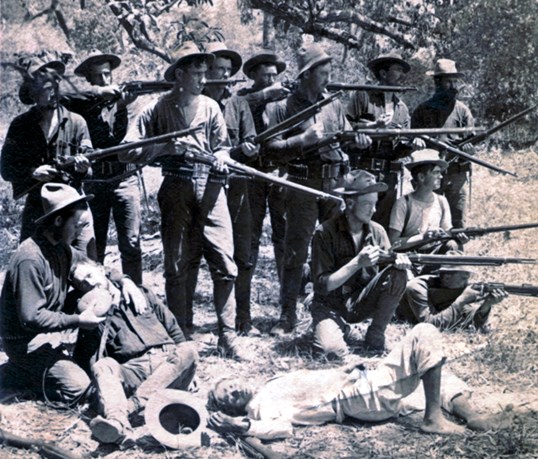
The Krag went head-to-head with the bolt-action Spanish Mauser Model 1893, which used a smokeless powder round known as the 7x57mm Mauser. This was an interesting example of two modern rifles facing off in combat.
The Spanish Mauser reportedly outclassed the Krag in combat. In the battle of San Juan Hill, 750 Spanish soldiers held off 8,500 U.S. Troops. Its longer effective range, as well as the stripper clip reloading feature, made the Spanish Mauser a force multiplier.

San Juan Hill caused the United States Army to convene a board of investigation on the Krag. They realized the weakness of the .30-40 cartridge, the lack of ability to use stripper clips, and the issues with the cumbersome side loading gate.
Other Rifles
While the Krag and the Mauser were the standard-issue rifles of the time, that didn’t mean they were the only players on the board.
Production was nowhere near as fast, and some U.S. Soldiers carried old Springfield M1873 Trapdoor carbines into battle. Handfuls of lever-action rifles also saw combat; Winchester lever guns were extremely popular and offered a lighter, faster firing option for troops on the move.
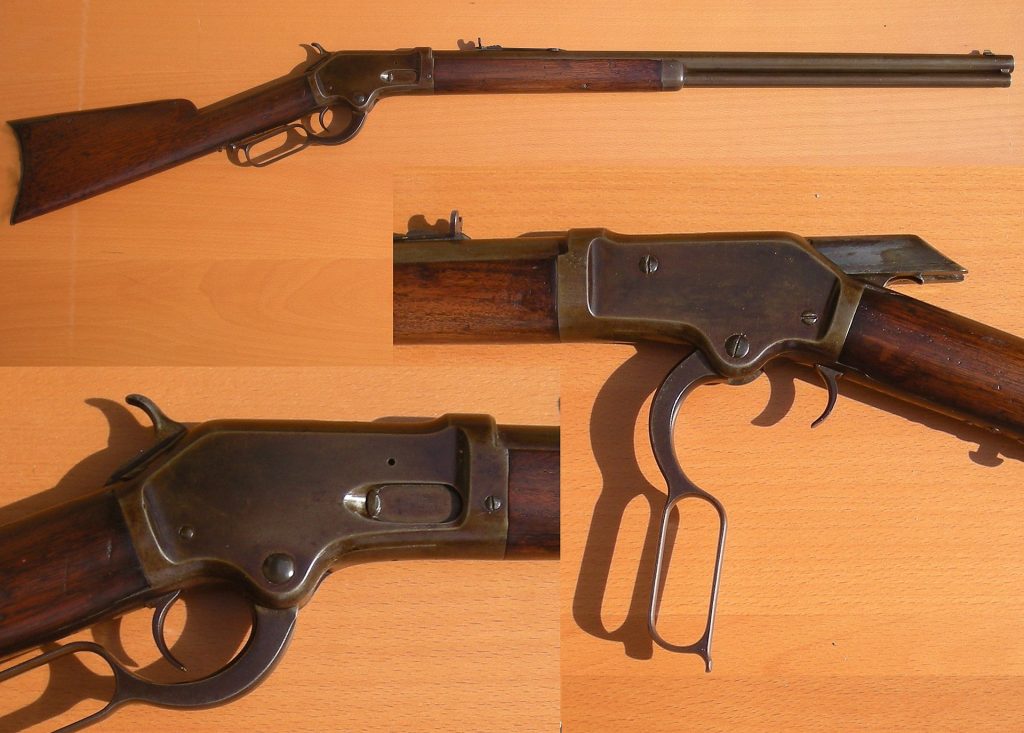
The Colt-Burgess and even the Colt Lightning rifle found their way to Cuba. Additionally, the Remington-Lee M1885 .45-70 bolt action rifle saw use in Spain in limited numbers.
The Amphibians
The Marines and Navy did their own thing and fielded the M1895 Lee Navy rifle chambered in the 6mm Lee Navy.

These rifles used a straight pull system and were fed from a 5-round internal box magazine that used en-bloc clips. The Lee Navy was rather reliable, and the Marines used it to great effect.
Armed with a lighter rifle and ammunition, the Marines could carry more ammo and sustain their assaults long after Cuban forces ran low on ammunition.
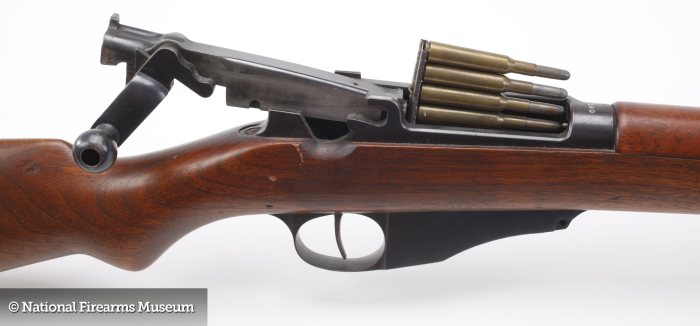
The guns also proved handy when navigating the mountainous terrain and jungle environment, and the flat shooting 6mm cartridge was ahead of its time.
Sidearms
The U.S. Army fielded a dozen different revolvers at the time. Everything from the old Colt SAA to the Smith and Wesson Model 3 found its way overseas.
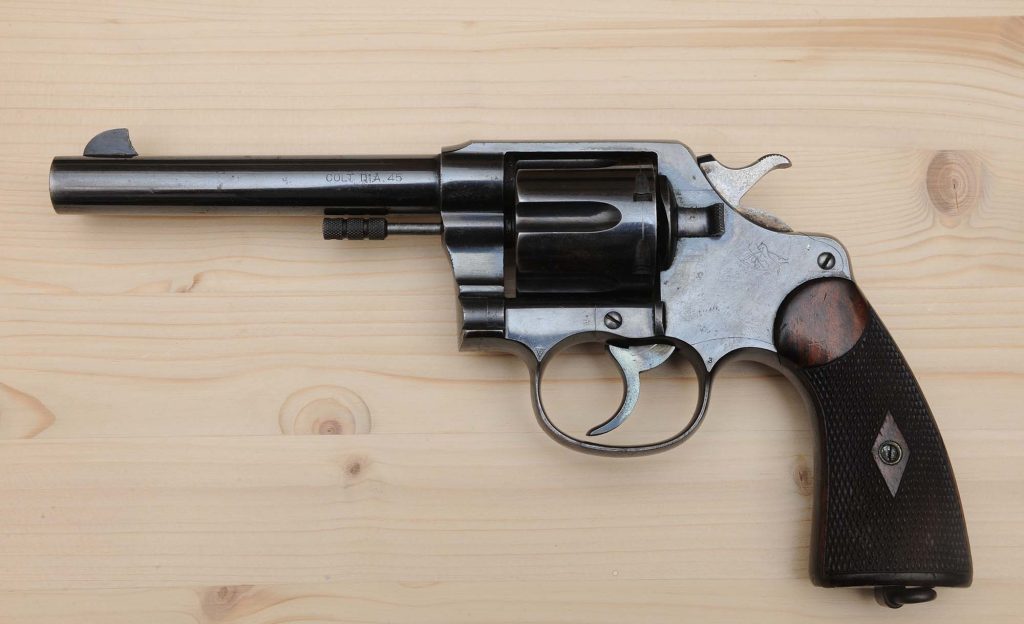
Officially, the Colt New Service was the US Military’s handgun of choice in .38 Long Colt.
The Colt New Service, or Model 1909, was a six-shot revolver that utilized a modern double-action configuration. The relatively new swing-out cylinder design allowed soldiers to reload rapidly compared to the old gate-loading guns.
While the .38 Long Colt seemed to work fine in Cuba, it reportedly didn’t offer enough ‘stopping power’ during the Moro rebellion.
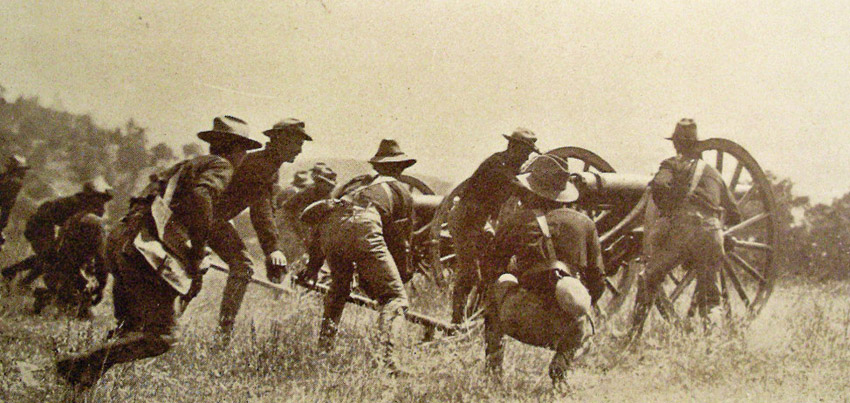
Having been adopted the same year the US went to war with Spain in Cuba, there were not enough 1909s to outfit the entire army. Other revolvers that remained in service included the Colt models M1877, 1878, 1889, and 1892.
Besides these more modern revolvers, the Colt SAA, Colt M1871, Remington M1875, S&W Model 3, and others were still in use.
The Spanish wielded the C96, making it one of the early uses of a semi-auto in a war. A blistering speed of 1,450 feet per second was achieved with is 7.63x25mm Mauser cartridge. C96 wielders had 10 rounds to disperse and could reload quickly with stripper clips.
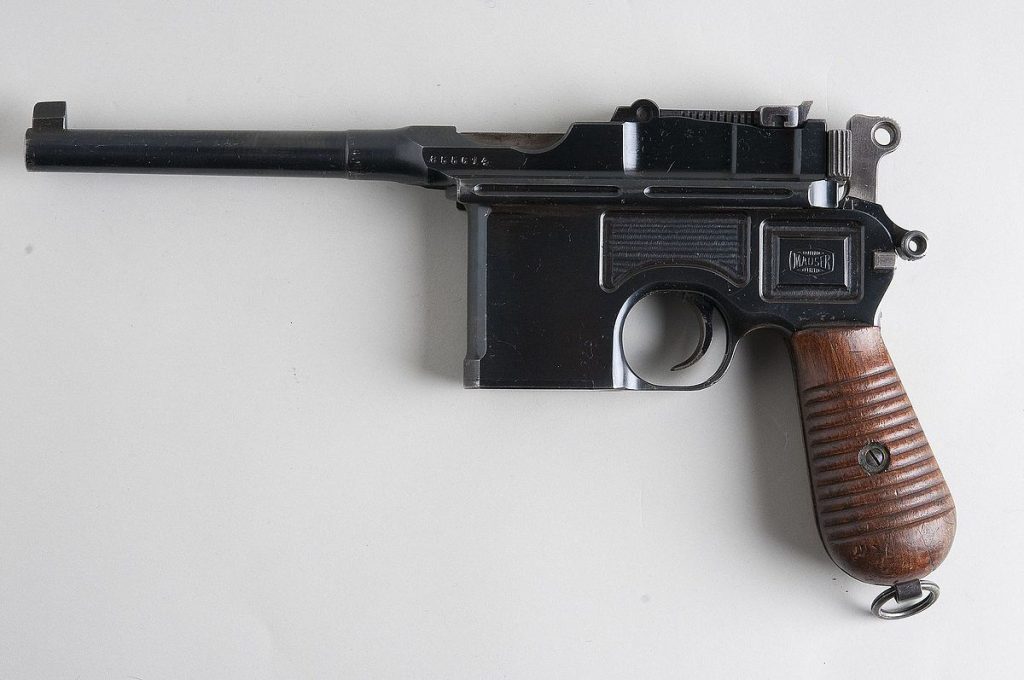
Spaniards also wielded the Orbea No. 7, a Spanish-produced clone of the S&W Model 3 in .44 Russian. It was a fine revolver but showing its age by the Spanish-American war. The single-action design was simple, and the break-open cylinder allowed for rapid reloads.
Machine Guns
While World War 1 was truly the machine gun war, the Spanish-American war saw both sides use modern machine guns. The US utilized a mix of Gatling guns and Colt M1895 Machine guns.
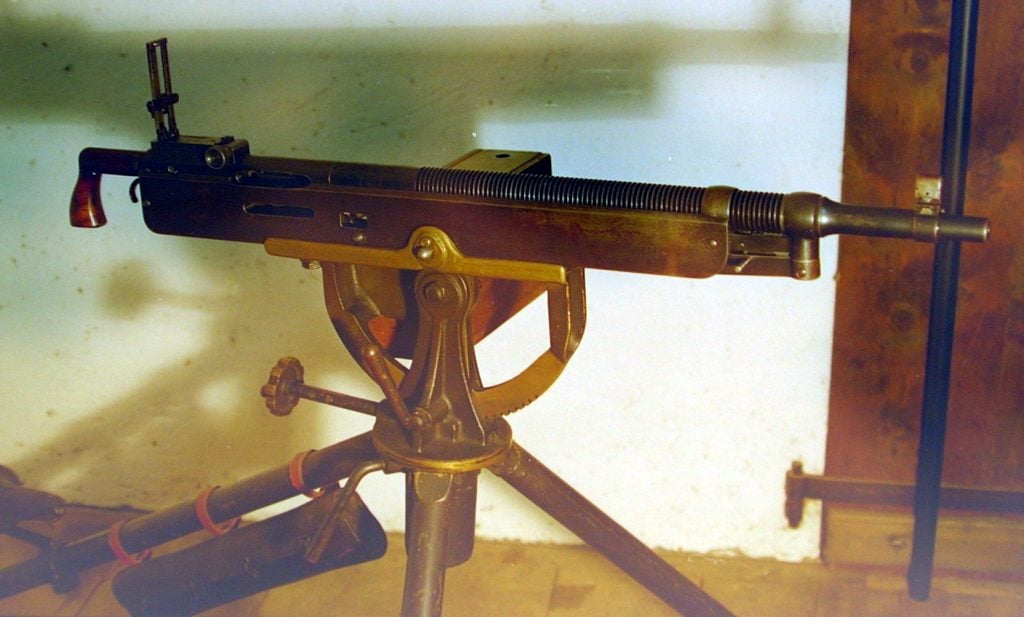
John Browning designed the M1895 Colt, which earned the name potato digger due to the oddball operating mechanism underneath that would dig a hole if it got too low to the ground.
The Colt M1895 was essentially a fully automatic lever-action rifle that fed from a belt.
Marines wielded the M1895s in 6mm Lee Navy, marking the first time modern machine guns were used to provide suppressive fire to cover an infantry assault. Conversely, the Army still utilized the large, aging, black powder Gatling guns.
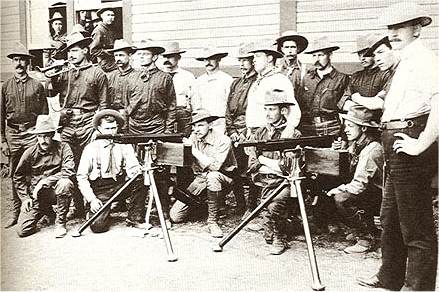
The Rough Riders famously carried two M1895 Colt machine guns in 7×57 Mauser that were gifted by family members of Rough Rider volunteers.
Roosevelt was famously not very impressed by the guns, calling them fragile. However, the Marines seemed to love it and continued using it during their excursions worldwide.
Once more, the Spanish showed themselves to be a very modern army with their Maxim gun in 7×57 Mauser. While it was older than the Marines M1895, the Maxim was a very robust gun capable of laying down reliable fire.
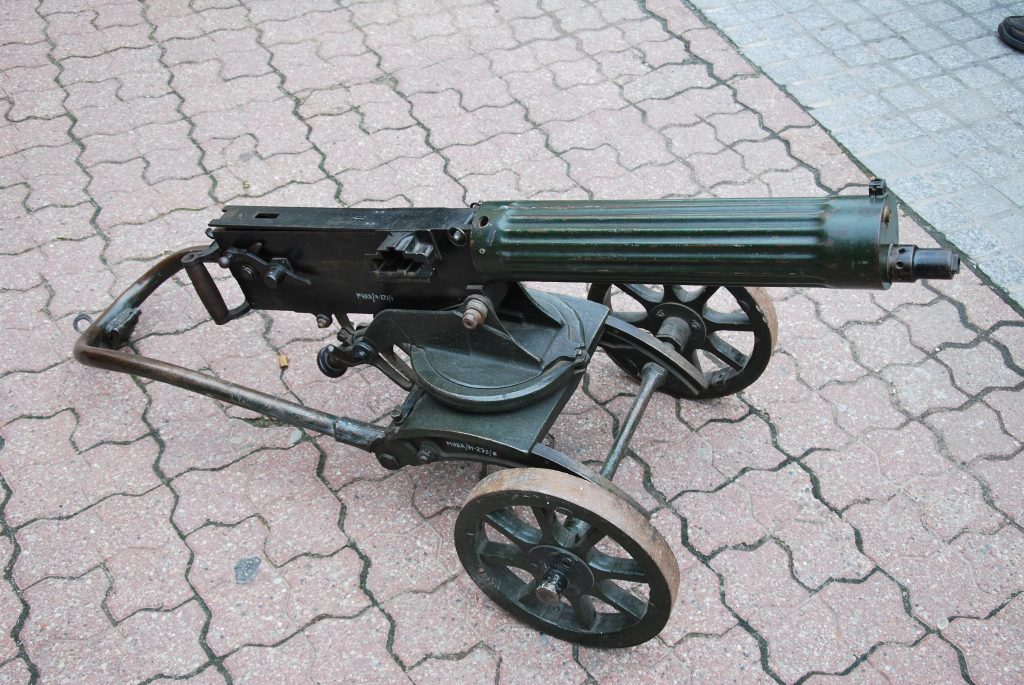
The Maxim utilized a more conventional recoil operation and was a belt-fed, water-cooled gun that served with dozens of armies around the world, giving fighting forces a force multiplier on the battlefield that delivered brutally effective fire.
Final Thoughts
The Spanish-American war proved to be a prologue for World War 1, at least as far as small arms go.
Rifles were bolt-action repeaters, handguns were double-action revolvers or semi-autos, and machine guns made their widespread debut.
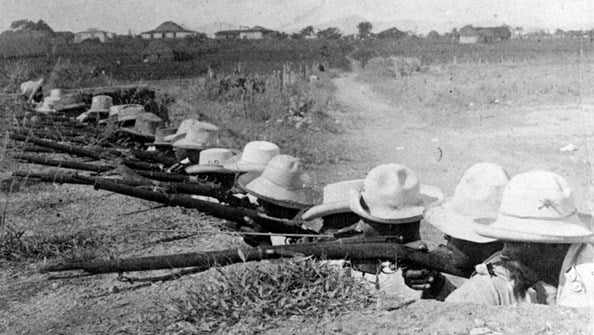
As always, war proved brutal, and firearms technology continued to develop. Without the lessons from Spanish-American War, American soldiers may have entered World War I with outdated Krag rifles.
What’s your favorite firearm of this period? Are there any I missed? Let us know in the comments below! Interested in more gun history? Check out our article, Firearm Firsts: Historical Guns That Laid the Groundwork!

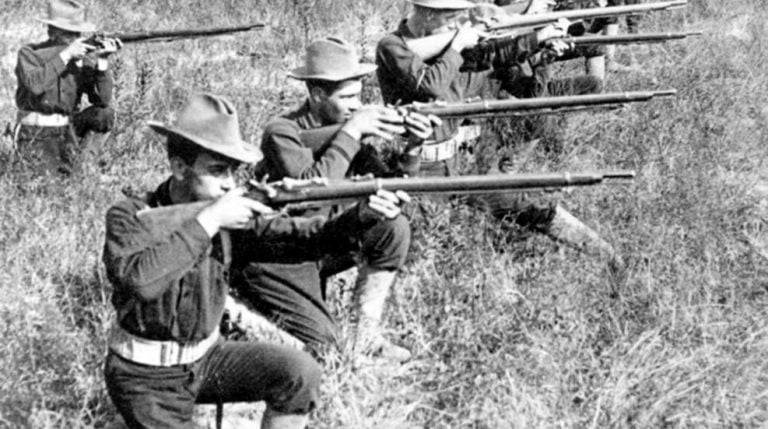
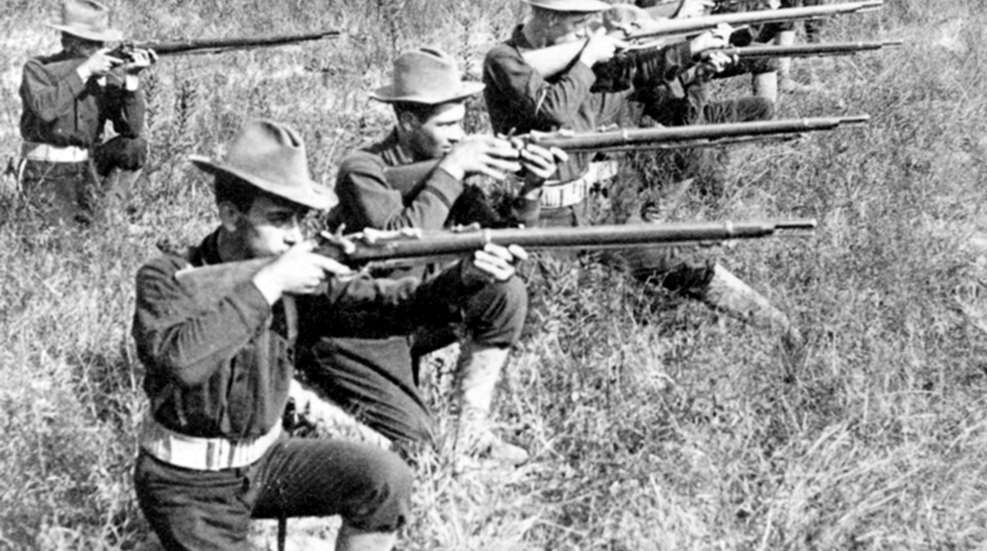




Leave a Reply